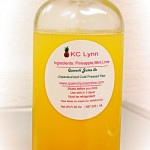Health benefits of Kale (borecole) *
 Kale is a very versatile and nutritious green leafy vegetable. It is a widely popular vegetable since ancient Greek and Roman times for its low fat, no cholesterol but health benefiting anti-oxidant properties.
Kale is a very versatile and nutritious green leafy vegetable. It is a widely popular vegetable since ancient Greek and Roman times for its low fat, no cholesterol but health benefiting anti-oxidant properties.- Kale, like other members of the Brassica family, contains health-promoting phytochemicals, sulforaphane and indole-3-carbinol that appear to protect against prostate and colon cancers.
- Di-indolyl-methane (DIM), a metabolite of indole-3-carbinol is an effective immune modulator, anti-bacterial and anti-viral agent through its action of potentiating “Interferon-Gamma” receptors.
- Borecole is very rich source of β-carotene, lutein and zea-xanthin. These flavonoids have strong anti-oxidant and anti-cancer activities. Beta-carotene is converted to vitamin A in the body.
- Zea-xanthin, an important dietary carotenoid, is selectively absorbed into the retinal macula lutea in the eyes where it is thought to provide antioxidant and protective light-filtering functions. Thus, it helps prevent retinal detachment and offer protection against “age-related macular degeneration related macular degeneration disease” (ARMD) in the elderly.
- It is very rich in vitamin A, 100 g leaves provide 512% of RDA. Vitamin A is required for maintaining healthy mucus membranes and skin and is essential for vision. Foods rich in this vitamin are known to offer protection against lung and oral cavity cancers.It is one of the excellent vegetable sources for vitamin-K; 100 g provides about 700% of recommended intake. Vitamin K has potential role bone health by promoting osteotrophic (bone formation and strengthening) activity. Adequate vitamin-K levels in the diet help limiting neuronal damage in the brain; thus, has established role in the treatment of patients suffering from Alzheimer’s disease.
- 100 g of fresh leaves contain 120 mg or 200% of daily-recommended levels of vitamin C. Scottish curly leaf variety yet has more of this vitamin, 130 mg/100g. Vitamin C is a powerful antioxidant, which helps the body develop resistance against infectious agents and scavenge harmful oxygen-free radicals.
- This leafy vegetable is notably good in many B-complex groups of vitamins such as niacin, vitamin B-6 (pyridoxine), thiamin, pantothenic acid, etc., that are essential for substrate metabolism in the body.
- It is also rich source of minerals like copper, calcium, sodium, potassium, iron, manganese, and phosphorus. Potassium is an important component of cell and body fluids that helps controlling heart rate and blood pressure by countering effects of sodium. Manganese is used by the body as a co-factor for the antioxidant enzyme, superoxide dismutase. Iron is required for cellular oxidation and red blood cell formation.
* Information on this page cited from: http://www.nutrition-and-you.com/kale.html



